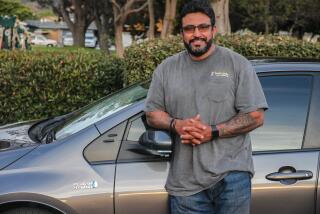Lightning-Fast Car Set for Record Try
- Share via
The car, “White Lightning,” looks more like a rocket ship, reaches speeds of more than 250 mph and runs on batteries that power children’s toys.
The owner, Edward Dempsey, owns seven U.S. patents and has three pending, all of them having to do with electric power systems.
The driver, Pat Rummerfield, overcame an injury that left him an incomplete quadriplegic, a man so determined he completed the 1992 Ironman Triathlon 19 years after hi car accident.
Dempsey, of Huntington Beach, and Rummerfield will be at Bonneville (Utah) Nationals Speedweek beginning Saturday for the final shakedown of White Lightning, its last test before trying to pursue a two-way land speed record in October.
“It’s a pretty expensive hobby,” Dempsey said of his $1-million investment, “for something that could conceivably fail.”
Any marks set this week won’t be official world records because Federation Internationale de l’Automobile, the governing body, won’t be present. But Dempsey expects to set an event and track record.
White Lightning’s eventual two-way target is 215.289 mph, set by driver Eric Lueben and Fontana-based Rannberg Team Racing in 1997. The figure is the average speed of two passes in opposite directions. Both passes must take place within 60 minutes.
Rummerfield set the one-way record, 237.18 mph, in 1997, a mark he expects to surpass this week.
He reached 260 mph last year, but lightning struck the timing stand and wiped out the data.
“I know the car can go 300,” Rummerfield said. “At 260, it still has a lot of room to go, it’s still accelerating.”
White Lightning is 25 feet long, 26 inches wide and weighs 2,450 pounds. From a dead stop, it can reach 100 mph in eight seconds. It is pushed by two 200-horsepower alternating current motors and controllers.
The car was built in Dempsey’s World Record Associates shop in Santa Ana, overseen by Mission Viejo’s Robert Kubinski. He worked previously on developing processing equipment to manufacture the space shuttle, F-18 aircraft and cruise missiles.
The car is powered by 6,120 “C-cell” batteries. Dempsey signed a contract last month with Energizer to use nickel metal hydride batteries instead of the NiCad batteries used previously.
“A lot of the data we get off this effort will help boost battery technology,” Dempsey said. “One of the problems with electrical cars now is the battery performance. They haven’t designed a battery that will last any amount of time at a high power output.”
He also hopes to build a vehicle that will go more than 1,000 miles on a single battery charge.
It’s the latter goal that ultimately will prove pivotal in the electric car universe.
“The 1,000-mile car at 65 mph--that is a real technical challenge,” Dempsey said. “Saturn’s EV-1 will go about 120 miles at 50 mph.
“We have formed a group of engineers and racers with a common goal, to push the envelope of existing technology by going faster, farther, quicker, and at the same time showcase the potential for electric power for personal transportation.”
Dempsey, who founded Concrete Coring Co. in Los Angeles in 1961, is familiar with research and development. He developed several new technologies and equipment for the concrete-cutting industry, which led to the motors used in White Lightning.
Dempsey also has a racing history; he raced cars from 1961-68, and won a Formula One Outboard boating world title in 1984.
“I’d like to show people that electric cars aren’t golf carts--they can be fast and fun,” Dempsey said. “Someday, there will be a lot of electric cars.”
Rummerfield, 45, brings a human interest to this technological quest.
In 1974, he had just turned 21, and had been drinking with his best friend, who was driving Rummerfield’s Corvette. They hit a ditch while doing 135 mph.
The friend chipped a tooth. Rummerfield suffered massive head and neck injuries that left him paralyzed from the neck down. Doctors figured he had three days to live.
He suffered a serious compression fracture of his cervical vertebrae. His spinal cord remains damaged.
For three months, Rummerfield was able to move only his eyes, tongue and lips. Months later, he gradually regained movement in his toes, and later, his arms.
“It took me three years to be able to walk and use my hands,” said Rummerfield, who lives in Belleville, Ill. “It took me 17 years to master jogging or any kind of fast moving.
“At first, I didn’t have the strength, or the endurance, or any fast-twitch skills. It took a lot of years of therapy. I’m still in therapy.”
In 1992, he completed the Ironman Triathlon in Hawaii. It took him 16 hours, 18 minutes, 54 seconds to complete a 4.2-mile swim, 110-mile bicycle ride and 26.2-mile run. He was 1,264th out of 1,433 competitors.
Rummerfield, who is training for the Sahara Marathon--150 miles on foot in the Sahara Desert--has regained about 75% of his normal ability. He coordinates studies in the injury prevention center at Washington University School of Medicine in St. Louis, and is active in drunk driving prevention programs.
He says it is an unusual feeling to be pushing toward 300 mph in a vehicle that makes no noise.
“The car’s not loud,” Rummerfield said. “You hear the whining of the belt. But the salt, the salt sounds like a sandblaster.”
More to Read
Sign up for Essential California
The most important California stories and recommendations in your inbox every morning.
You may occasionally receive promotional content from the Los Angeles Times.













